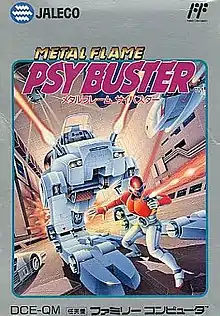Metal Mech
Metal Mech: Man & Machine (known in Japan as Metal Flame: Psybuster (メタルフレーム・サイバスター)) is a 1990 video game for the Nintendo Entertainment System.
| Metal Mech: Man & Machine | |
|---|---|
 Japanese cover art | |
| Developer(s) | Sculptured Software[1][2] |
| Publisher(s) | Jaleco[1][2] |
| Designer(s) | Joe Hitchens |
| Programmer(s) | Ken Grant |
| Composer(s) | Paul Webb |
| Platform(s) | Nintendo Entertainment System |
| Release | |
| Genre(s) | Action[1] |
| Mode(s) | Single-player[3] |
Summary

The player controls the driver of a vehicle that is similar to the ED-209 of the RoboCop franchise.[4]
The player must clear levels filled with randomly generated enemies in an unnamed city in order to survive.[4] Items that can upgrade the firepower and defense of the vehicle are hidden in crates.[4] Players must spend as much time outside of the armored unit as they do inside because the mech is a bigger (but tougher) target.[4] They must also leave the mech to climb ladders that lead to needed items and to advance the game's storyline.[4] However, veteran gamers of this genre have noted more than a few similarities to Blaster Master.[5] The "little person" has a virtually identical appearance to Jason in the Blaster Master video game. Controlling the person is easier than controlling the mech.[5] Players have to collect radiation symbols around the city, which was also the main point of Blaster Master.[5]
External links
- Metal Mech at GameFAQs
- Metal Flame PsyBuster at Famicom World
- Metal Mech: Man & Machine at UV List
- Metal Mech at MobyGames
- Metal Mech vs Blaster Master at Flying Omelette